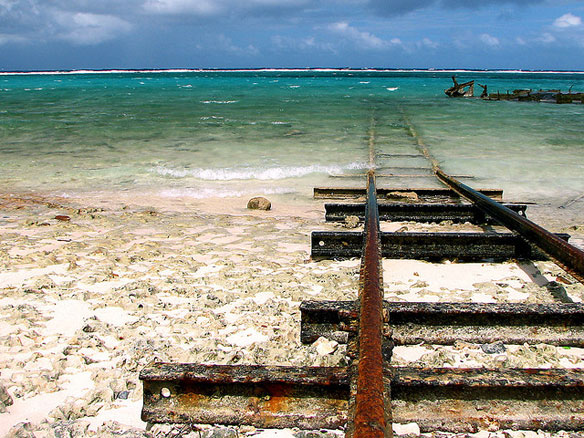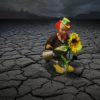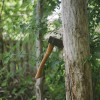So how exactly will global warming effect us? We are not really sure but scientists are constantly gathering information about how it is impacting us and making predictions about what will happen next. There are many people who believe that global warming is just a ‘myth’ and something that they really shouldn’t be concerned about because it will never happen in their lifetime, however there is irrefutable evidence that climate is changing so here is 10 Signs Global Warming is Happening Now:
10) Carbon Dioxide Concentrations are increasing in the atmosphere
Scientists analysed air bubbles trapped in the ice of Antarctica and Greenland and was able to find that over the past 650,000 or more years, atmospheric concentrations of carbon dioxide varied between 180 and 300 parts per million and in the years immediately after the Industrial Revolution this stood around 280 parts per million. Ever since then it has increased at a pretty steady rate and there is evidence to show it has already passed 310 and is well on its way to 400 ppm
The problem with having so much carbon dioxide in the air is that we know it’s a greenhouse gas and that we are pumping around 90 million tons everyday into the atmosphere this will increase the effect and therefore lead to warming.
9) Hottest decade on record keeps changing

Averaged over all land and ocean surfaces, global mean temperatures have increased by about 1.33 degrees Fahrenheit (0.74 degrees Celsius) over the past century. This is clearly linked proof that the carbon dioxide concentrations are surely making the temperature rise in the atmosphere.
8) Arctic ocean is becoming more acidic
Scientists with the Arctic Monitoring and Assessment Programme in Oslo, Norway, monitor changes in the chemistry of the Arctic Ocean and said that over the past 200 years, the average acidity of ocean waters around the world has increased by about 30 percent. A study shown shows that in the next 10 years the north pole sea water is likely to hit corrosive levels which will put major disruption in the food chain and at the rate it is going at by the end of the century the Arctic ocean will hit corrosive levels of acidity.
The Arctic is particularly vulnerable to increasing carbon dioxide emissions, as CO2 is absorbed into cold water more easily. Even if all carbon dioxide emissions stopped immediately, it would take tens of thousands of years for the Arctic to return to the acidification levels that prevailed before the dawn of the Industrial Revolution some 250 years ago.
7) Mount Everest’s Ice is Melting

Earth’s global thaw has even reached Mount Everest, the world’s tallest peak, according to a report released in Cancun, Mexico. Evidence shows that in the last 50 years the glaciers have shrunk by around 13% and continues to do so. The snow line has also shifted 590 feet upwards on Everest.
Students at the University of Milan tracked changes to glaciers, temperatures and precipitation at Everest and the surrounding Sagarmatha National Park. There, glaciers have retreated an average of 1,300 feet since 1962, the team found. More recently, precipitation has dropped by 3.9 inches and temperatures have risen 1 degree Fahrenheit since 1992.
6) The rate of warming is like no other

Of course the earth has historically gone through many shifts. It has been, at various times, both much warmer and much colder on average than it is now. But unlike before without including factors like solar activity and tilts in the planet’s axis it seems like the earth warming isn’t due to any natural factors. The speed at which it is going at also appears that it is caused by humans.
Last year, a study combined data from 73 sites around the world to show that temperatures today are warmer than they have been during 70-80 percent of the Holocene Epoch (time since the last ice age) and that, under all existing scenarios for different levels of greenhouse gas emissions, almost every model shows temperatures will exceed the very hottest periods during that time.
5) The ice in the Arctic is melting

We’ve all heard it before but a lot of us have never really seen the facts. The Arctic Ocean is now decreasing by a rate of about 13 percent per decade, compared to the 1979-2000 average. in 2012, Arctic sea ice extent reached its lowest level in the satellite record, fully 760,000 square kilometers (293,000 square miles) below the previous record, which occurred in 2007. That difference is an area about the size of the state of Texas. The 2012 minimum was in turn 3.29 million square kilometres (1.27 million square miles) (or 49 percent) below the 1979 to 2000 average minimum, representing an area nearly twice the size of the state of Alaska.
4) The Caribbean

For the people of the Caribbean there is no theory or prediction about this because the people living there can already see this happening now.
The people along the stretch of eastern Grenada have watched the sea eat away at their shoreline in recent decades, a result of destructive practices such as extraction of sand for construction and ferocious storm surges made worse by climate change, according to researchers with the U.S.-based Nature Conservancy, who have helped locals map the extent of coastal erosion. This has forced the locals to move to higher ground for protection against their homes for the near future.
3) Sea levels rising globally

Much like the last point this is not just a 1 country issue this is a global issue which is happening. despite what people say about the situation, multiple measurements using both satellites and tide gauges show a rise in global sea levels. On average, since 1993, the sea has been rising by 3.18mm annually primarily as a consequence of thermal expansion due to warming, and to the melting of ice sheets.
Sea levels underwent a sharp fall in 2010, however NASA conducted research to show that this was due to one of the strongest El Niño‘s in recent memory. This sudden shift in the pacific changed rainfall patters globally which brought massive floods to Australia and the Amazon basin. The water to power that rainfall came from the ocean, the level of which consequently dipped. Since then, sea level has resumed rising at an accelerated clip of approximately 10 mm a year.
2) Arctic ice shrinks to an all time low

The sheet of ice that covers the North Pole melted to its smallest size on record in August 2013, shattering the previous record set just five years ago and providing a strong sign of the long-term warming of the earth’s climate. While the extent of the Arctic sea ice varies every year due to changing weather conditions such as storms tearing off large chunks of ice, however it has declined dramatically since regular observation began more than 30 years ago.
The yardstick climate scientists use to measure the ice sheet’s coverage over the polar ice cap fell to about 1.58 million square miles by Aug 26, the National Snow and Ice Data Center (NSIDC) announced. With this pace keeping up where could this lead in the near future?
1) Extreme weather is getting even worse

Making a direct connection between climate change and extreme weather events is not straightforward. Weather, after all, is short-term and highly variable. There have always been and always will be storms and heatwaves. There, however seems to be strong links between global warming and extreme weather and scientists have long suspected that a changing climate will make certain weather events more likely and others more extreme.
For example, a warming ocean, while actually making it more difficult for hurricanes to form, when they do form they become much more stronger. When major storms do strike, higher sea levels will result in greater storm surges and coastal flooding. As the Arctic warms, circumpolar wind patterns are becoming disrupted, altering the course of the jet stream, which steers weather systems from west to east around the northern hemisphere. Weather systems in turn are progressing more slowly, raising the chances for long-duration extreme events, like droughts, floods, extreme snowfall in winter, and heat waves.
So there you have it 10 signs global warming is happening right now. What is your take on the situation? What is the solution?
Sources:
http://nsidc.org/arcticseaicenews/2012/09/arctic-sea-ice-extent-settles-at-record-seasonal-minimum/
http://www.thinkglobalgreen.org/carbondioxide.html
http://co2now.org/
http://www.eia.gov/oiaf/1605/ggccebro/chapter1.html
https://www2.ucar.edu/climate/faq#t2506n1341
http://iopscience.iop.org/1748-9326/6/4/044022
http://www.sciencedaily.com/releases/2013/03/130307145303.htm
http://onlinelibrary.wiley.com/doi/10.1029/2009GL040222/abstract
http://www.scientificamerican.com/article/scientists-trek-collapsing-glaciers-antarctica-meltdown/
http://www.nature.com/nature/journal/v436/n7051/full/nature03906.html
http://globalisation-and-the-environment.blogspot.co.uk/2010/10/weather-throws-punches-but-climate.html





